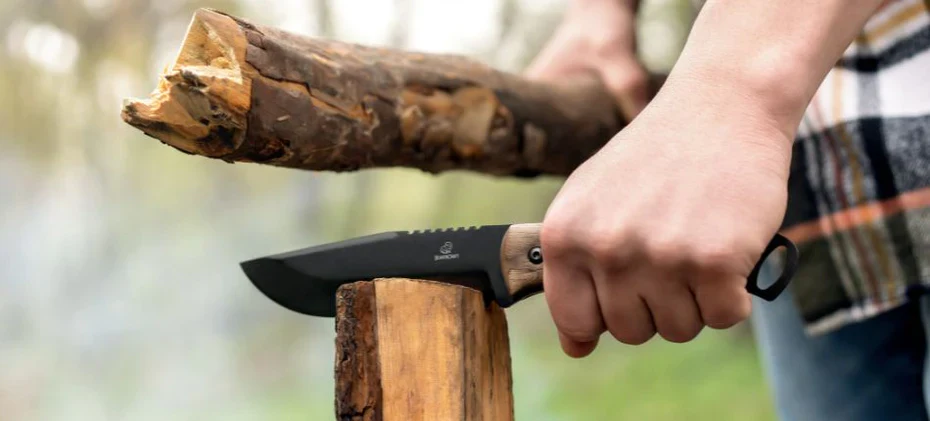Uncategorized
How to Select the Right Camping Knife for Safety and Utility
When you’re preparing for a camping trip, one of the most essential pieces of gear you can pack is a good camping knife. Whether you’re hiking through rugged terrain, setting up camp, or preparing food, a reliable knife can make a world of difference. But with so many options available, it can be difficult to determine which one best suits your needs. Choosing the right camping knife requires a balance between safety, utility, durability, and comfort. In this guide, we’ll break down everything you need to know to select the right camping knife for your outdoor adventures.
Why You Need a Camping Knife
A camping knife is an indispensable tool that can serve a variety of functions, such as:
- Food Preparation: Cutting vegetables, meats, and other camp food.
- Fire Starting: Helping to chop kindling, carve fire starters, or even strike a ferro rod.
- Gear Repair: Cutting rope, removing gear from packaging, or helping with minor repairs.
- Safety and Self-Defense: Providing a means of protection in emergency situations.
- Survival: Creating shelters, hunting, or assisting in first aid.
Given its versatility, a camping knife can be your best friend on the trail, but you need to pick one that’s designed for the specific tasks you’ll need.
Key Considerations for Selecting the Right Camping Knife
Before choosing a camping knife, there are several factors to consider to ensure you get one that matches your needs. Let’s dive into each one:
1. Blade Type
The type of blade you choose depends on the activities you plan to do during your camping trip. Camping knives generally come in two categories: fixed blade and folding blade.
- Fixed Blade Knives: These knives have a solid, non-folding blade that is often stronger and more durable. They are ideal for heavy-duty tasks like batoning wood, cutting through thick vegetation, or using as a tool in survival situations.
- Pros: More durable, easier to clean, and better suited for heavy tasks.
- Cons: Bulkier and not as easy to carry or conceal.
- Folding Blade Knives: These knives feature a folding mechanism that makes them more compact and easier to carry. They’re great for lighter tasks like food preparation, cutting rope, or other general camping needs.
- Pros: More portable, lighter, and safer to carry.
- Cons: Less robust than fixed blades, and more prone to wear on the mechanism over time.

2. Blade Material
The material of the blade directly affects its sharpness, corrosion resistance, and ability to hold an edge. The two most common blade materials are stainless steel and carbon steel.
- Stainless Steel: Known for its resistance to rust and corrosion, stainless steel is great for knives that are exposed to moisture or wet conditions.
- Pros: Rust-resistant, easy to maintain, and durable in various weather conditions.
- Cons: Doesn’t hold an edge as long as carbon steel, and might need to be sharpened more frequently.
- Carbon Steel: Carbon steel blades are known for their sharpness and edge retention. These blades are easier to sharpen but are more prone to rust if not properly cared for.
- Pros: Holds an edge longer, easier to sharpen, and tougher in harder tasks.
- Cons: Requires more maintenance (especially cleaning and oiling) to prevent rust.
3. Blade Shape
The shape of the blade determines the types of tasks the knife is best suited for. Common shapes include:
- Drop Point: This is one of the most versatile blade shapes, with a curved spine that makes it perfect for slicing, chopping, and detailed tasks like food preparation or carving. Ideal for general-purpose camping knives.
- Clip Point: Featuring a sharp tip and a concave curve, this blade shape is great for precision tasks, such as skinning or piercing, but it can be less robust than a drop point for heavy-duty tasks.
- Tanto Point: A more angular design that is known for its piercing power and strength. It’s better suited for self-defense or tactical purposes than for general camping use.
- Sheepsfoot: This blade shape has a flat edge and is primarily used for tasks that require a straight cutting edge, such as chopping or cutting rope.
4. Handle Material and Design
The handle of a camping knife plays a major role in comfort, control, and safety. The material should offer a secure, non-slip grip, especially in wet or slippery conditions. Common handle materials include:
- Wood: Offers a traditional look and feel but may require more maintenance to prevent cracking or splintering. Wood handles can be beautiful and ergonomic, but they’re not the best choice in rainy or wet environments.
- Rubber: Provides a good, comfortable grip and performs well in wet conditions, but can wear down more quickly with heavy use.
- Plastic or Micarta: These are durable and provide a secure grip. Micarta (a composite material made of layers of linen or paper and resin) is especially popular in outdoor knives for its resilience and comfort.
- Metal: While metal handles offer strength and durability, they can be slippery and uncomfortable for prolonged use unless they are coated with a rubber or textured surface.
The handle should also have a tang that extends into the handle, which improves the knife’s strength. A full tang (where the blade and handle are made from a single piece of metal) offers maximum durability.
5. Size and Weight
The size and weight of your camping knife will significantly impact its portability and ease of use. Consider the following:
- Lightweight Knives: Easier to carry, particularly for backpackers and those on extended hikes. They’re great for general tasks and those who prefer to pack light.
- Heavier Knives: These tend to offer more strength and can handle heavy-duty tasks like chopping wood or batoning. However, they may be less comfortable for extended use or for tasks that require a more delicate touch.
Choose a knife size that balances comfort and utility—too big and it becomes cumbersome; too small and it may lack the strength for tougher tasks.
6. Safety Features
Safety should always be a top priority when using a camping knife. Consider the following features:
- Sheath: A high-quality sheath is essential to protect both the knife and you. Look for one that holds the knife securely and can be worn comfortably on your belt or backpack. A good sheath should also have a retention strap to prevent the knife from accidentally falling out.
- Locking Mechanism (for Folding Knives): If you choose a folding knife, ensure that it has a reliable locking mechanism, such as a liner lock or a back lock, to prevent the blade from accidentally closing during use.
- Finger Guard: Some knives come with a built-in guard to prevent your hand from slipping onto the blade.
7. Brand and Price
Some well-known brands specializing in quality camping knives include Morakniv, Benchmade, Gerber, Buck, and Spyderco. These brands are trusted for producing reliable, high-performance knives.
While a more expensive knife may come with additional features or superior materials, don’t feel pressured to overspend. Many budget-friendly knives, like the Morakniv Companion or the Ka-Bar Becker Necker, are excellent for camping without breaking the bank.
Popular Camping Knives
Here are a few popular options to consider for your next camping trip:
- Morakniv Companion: Affordable, durable, and with a sharp carbon steel blade. A great all-purpose fixed blade knife.
- Benchmade Griptilian: A folding knife with excellent ergonomics and a strong, corrosion-resistant blade.
- Ka-Bar Becker BK2: A robust fixed blade knife known for its strength, ideal for heavy-duty tasks like chopping and batoning.
- Gerber StrongArm: A versatile fixed blade with a rubberized handle for a secure grip, perfect for survival and tactical use.
Conclusion
Selecting the right camping knife requires a careful balance between utility, safety, and comfort. Whether you opt for a folding or fixed blade, it’s essential to consider the material, blade shape, handle design, and overall weight of the knife. A good camping knife should meet your specific needs, whether you’re preparing food, cutting rope, building shelter, or dealing with an emergency. By following these guidelines, you can select a camping knife that will be a reliable and valuable tool for your outdoor adventures.

